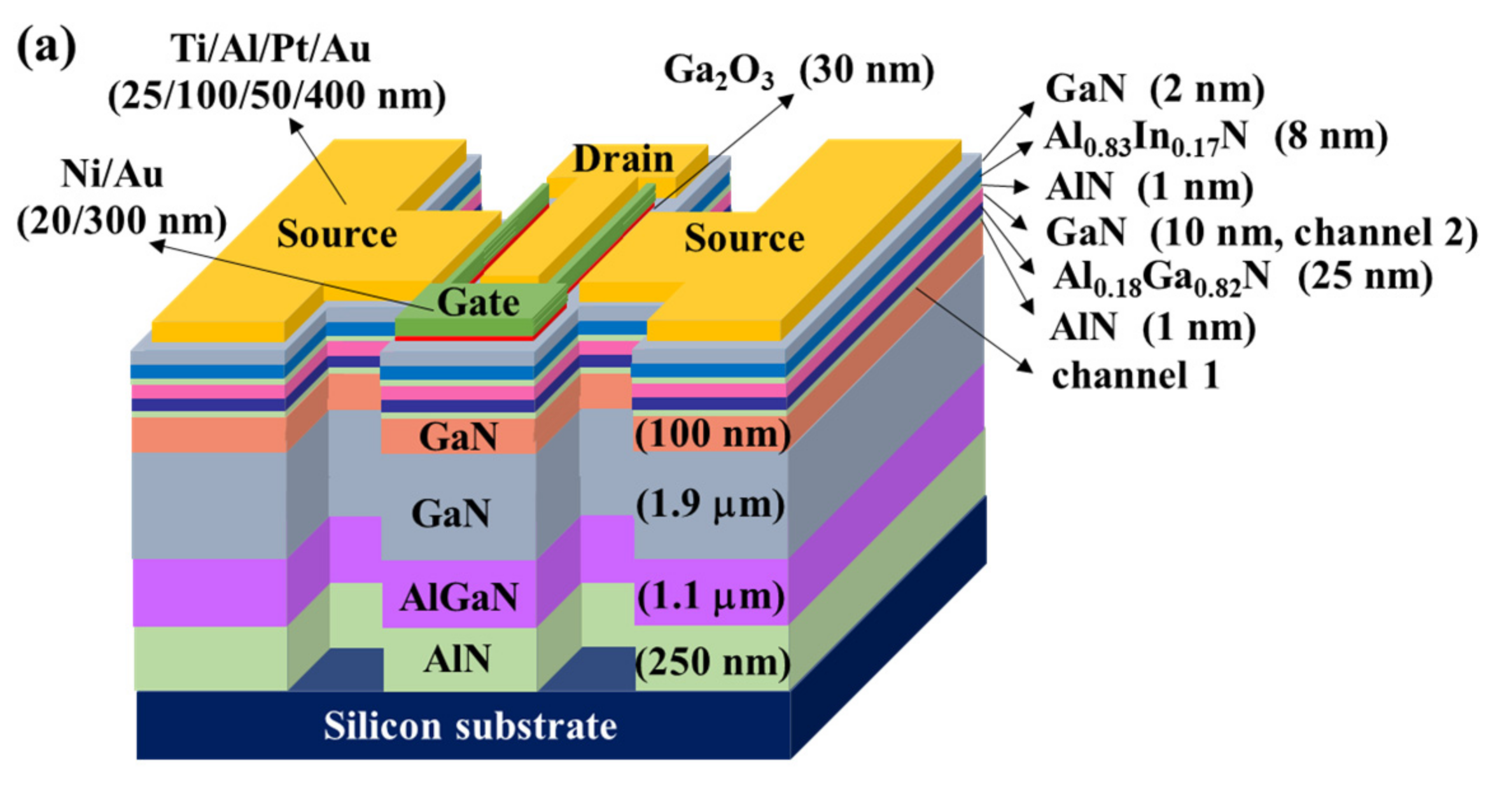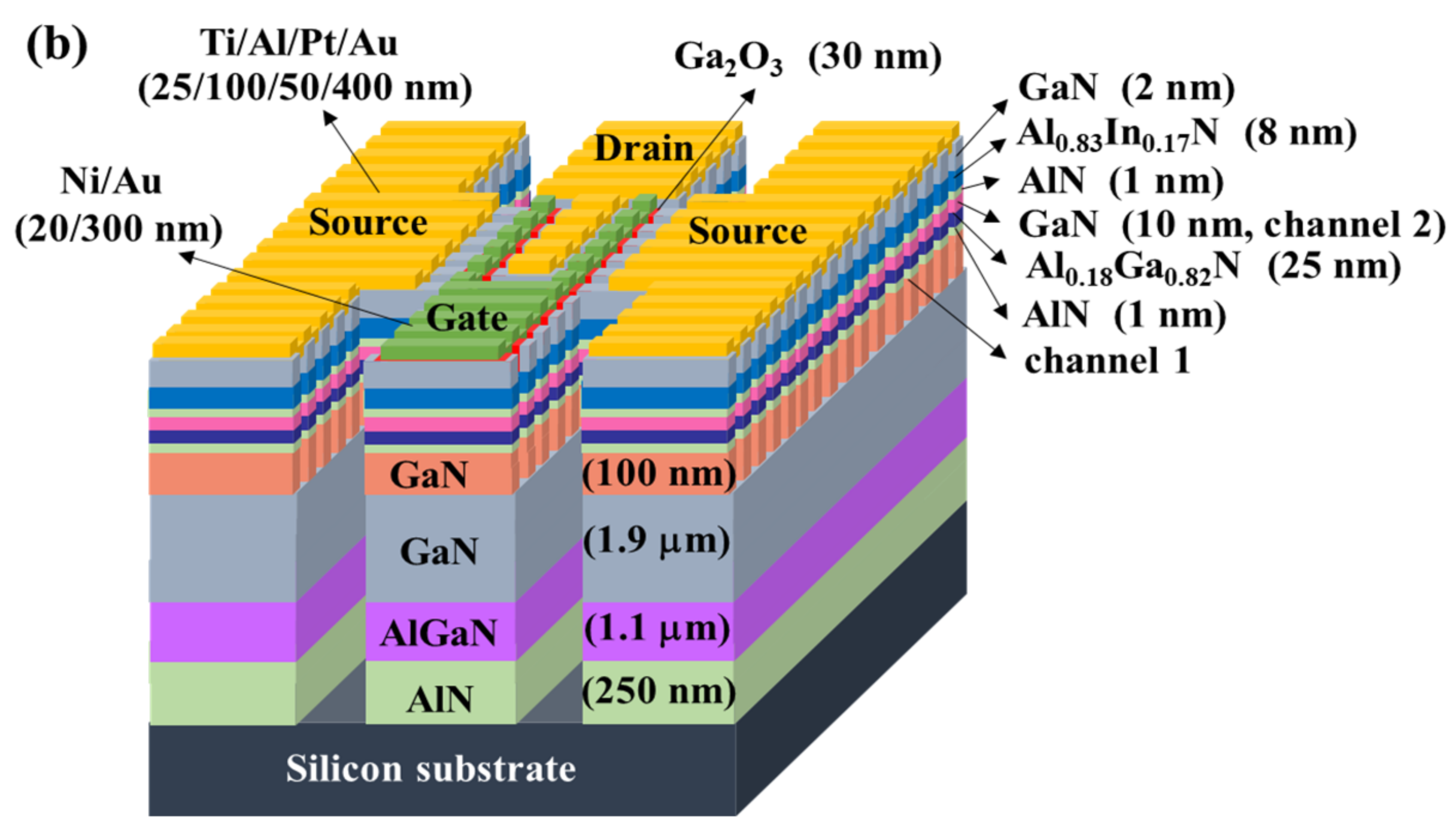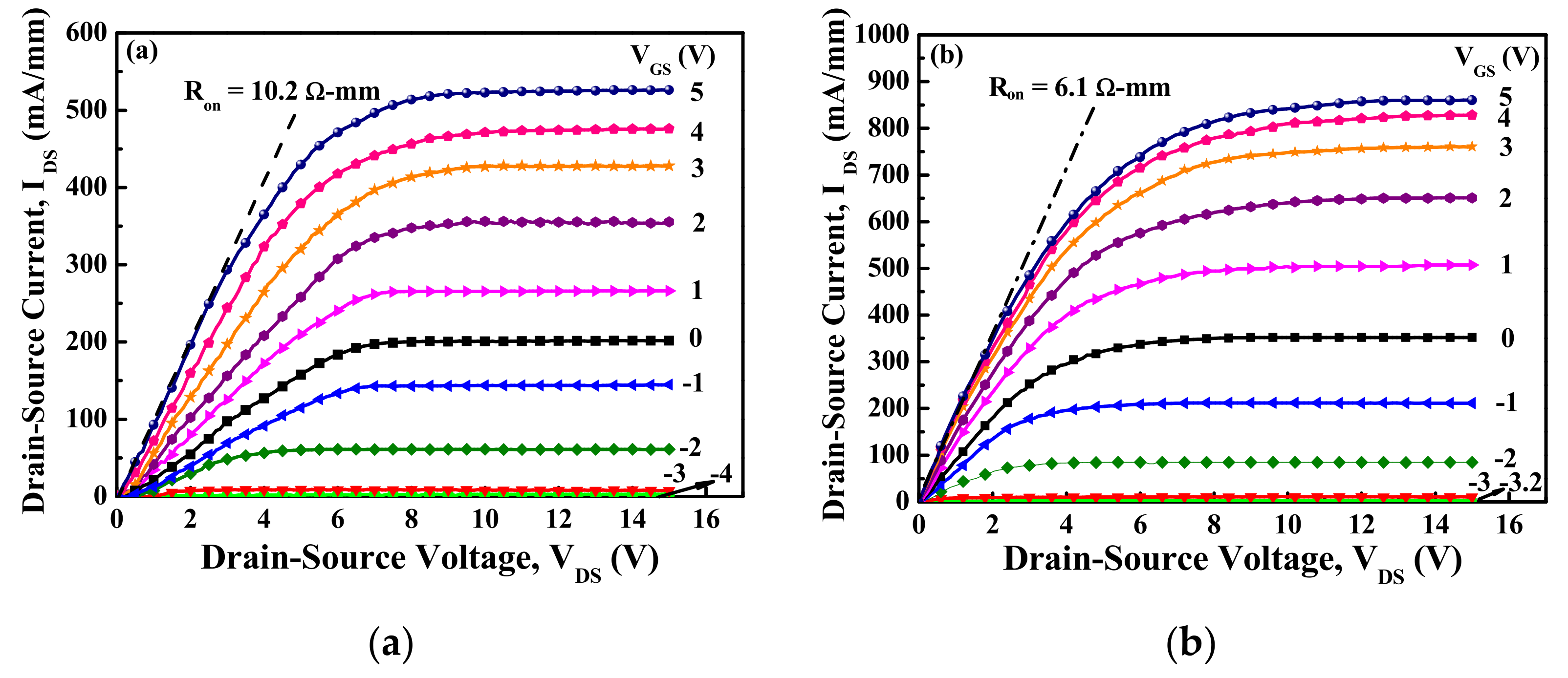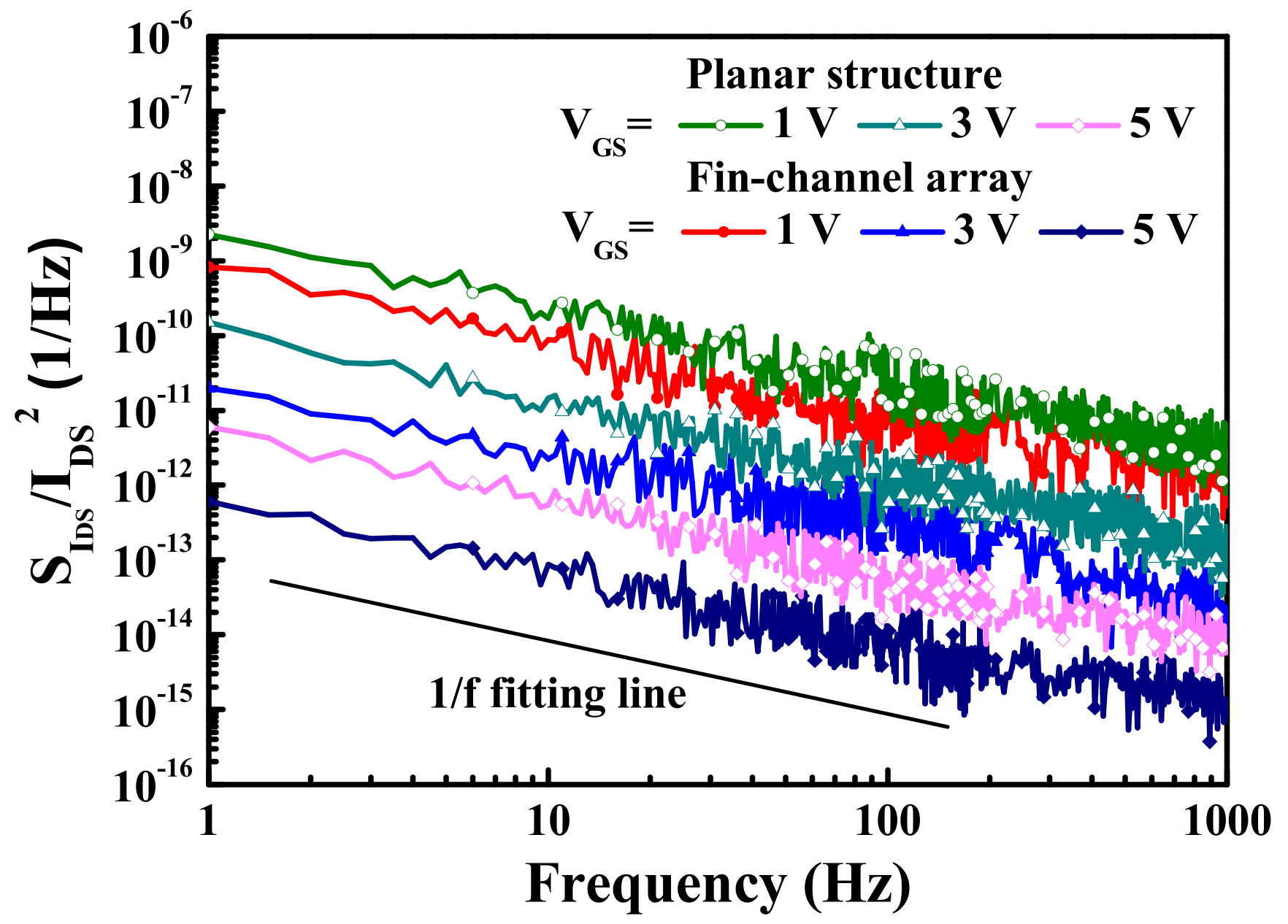Performance Comparison of Lattice-Matched AlInN/GaN/AlGaN/GaN Double-Channel Metal–Oxide–Semiconductor High-Electron Mobility Transistors with Planar Channel and Multiple-Mesa-Fin-Channel Array
Abstract
:1. Introduction
2. Epitaxial Growth and Results
3. Results and Discussion
4. Conclusions
Author Contributions
Funding
Institutional Review Board Statement
Informed Consent Statement
Data Availability Statement
Acknowledgments
Conflicts of Interest
References
- Roccaforte, F.; Greco, G.; Fiorenza, P.; Iucolano, F. An overview of normally-off GaN-based high electron mobility transistors. Materials 2019, 12, 1599. [Google Scholar] [CrossRef] [Green Version]
- Lee, H.Y.; Lin, C.H.; Wei, C.C.; Yang, J.C.; Chang, E.Y.; Lee, C.T. AlGaN/GaN enhancement-mode MOSHEMTs utilizing hybrid gate-recessed structure and ferroelectric charge trapping/storage stacked LiNbO3/HfO2/Al2O3 structure. IEEE Trans. Electron Devices 2021, 68, 3768–3774. [Google Scholar] [CrossRef]
- Zhang, S.; Ma, B.; Zhou, X.; Hua, Q.; Gong, J.; Liu, T.; Cui, X.; Zhu, J.; Guo, W.; Jing, L.; et al. Strain-controlled power devices as inspired by human reflex. Nat. Commun. 2020, 11, 326. [Google Scholar] [CrossRef] [PubMed]
- Heikman, S.; Keller, S.; Green, D.S.; DenBaars, S.P.; Mishra, U.K. High conductivity modulation doped AlGaN/GaN multiple channel heterostructures. J. Appl. Phys. 2003, 94, 5321–5325. [Google Scholar] [CrossRef]
- Chu, R.; Zhou, Y.; Liu, J.; Wang, D.; Chen, K.J.; Lau, K.M. AlGaN-GaN double-channel HEMTs. IEEE Trans. Electron Devices 2005, 52, 438–446. [Google Scholar] [CrossRef]
- Erine, C.; Ma, J.; Santoruvo, G.; Matioli, E. Multi-channel AlGaN/GaN In-plane-gate field-effect transistors. IEEE Electron Device Lett. 2020, 41, 321–324. [Google Scholar] [CrossRef]
- Chen, X.; Lv, D.D.; Zhang, J.F.; Zhou, H.; Ren, Z.Y.; Wang, C.; Wu, Y.; Wang, D.; Zhang, H.; Lei, Y.Y. Model of electron population and energy band diagram of multiple-channel GaN heterostructures. IEEE Trans. Electron Devices 2021, 68, 1557–1562. [Google Scholar] [CrossRef]
- Kamath, A.; Patil, T.; Adari, R.; Bhattacharya, I.; Ganguly, S.; Aldhaheri, R.W.; Hussain, M.A.; Saha, D. Double-channel AlGaN/GaN high electron mobility transistor with back barriers. IEEE Electron Device Lett. 2012, 33, 1690–1692. [Google Scholar] [CrossRef]
- Wei, J.; Liu, S.; Li, B.; Tang, X.; Lu, Y.; Liu, C.; Hua, M.; Zhang, Z.; Tang, G.; Chen, K.J. Low on-resistance normally-off GaN double-channel metal–oxide–semiconductor high-electron-mobility transistor. IEEE Electron Device Lett. 2015, 36, 1287–1290. [Google Scholar] [CrossRef]
- Jha, S.K.; Surya, C.; Chen, K.J.; Lau, K.M.; Jelencovic, E. Low-frequency noise properties of double channel AlGaN/GaN HEMTs. Solid-State Electron. 2008, 21, 606–611. [Google Scholar] [CrossRef]
- Joh, J.; Gao, F.; Palacios, T.; del Alamo, J.A. A model for the critical voltage for electrical degradation of GaN high electron mobility transistors. Microelectron. Reliab. 2010, 50, 767–773. [Google Scholar] [CrossRef]
- Lim, T.; Aidam, R.; Waltereit, P.; Henkel, T.; Quay, R.; Lozar, R.; Maier, T.; Kirste, L.; Ambacher, O. GaN-based submicrometer HEMTs with lattice-matched InAlGaN barrier grown by MBE. IEEE Electron Device Lett. 2010, 31, 671–673. [Google Scholar] [CrossRef]
- Mojaver, H.R.; Gosselin, J.L.; Valizadeh, P. Use of a bilayer lattice-matched AlInGaN barrier for improving the channel carrier confinement of enhancement-mode AlInGaN/GaN hetero-structure field-effect transistors. J. Appl. Phys. 2017, 121, 244502. [Google Scholar] [CrossRef]
- Shrestha, N.M.; Li, Y.; Chen, C.H.; Sanyal, I.; Tarng, J.H.; Chyi, J.I.; Samukawa, S. Design and simulation of high performance lattice matched double barrier normally off AlInGaN/GaN HEMTs. IEEE J. Electron. Devices Soc. 2020, 8, 873–878. [Google Scholar] [CrossRef]
- Chiou, Y.L.; Lee, C.T. Band alignment and performance improvement mechanisms of chlorine-treated ZnO-gate AlGaN/GaN metal–oxide–semiconductor high-electron mobility transistors. IEEE Trans. Electron Devices 2011, 58, 3869–3875. [Google Scholar] [CrossRef]
- Kim, H.S.; Kang, M.J.; Kim, J.J.; Seo, K.S.; Cha, H.Y. Effects of recessed-gate structure on AlGaN/GaN-on-SiC MIS-HEMTs with thin AlOxNy MIS gate. Materials 2020, 13, 1538. [Google Scholar] [CrossRef] [PubMed] [Green Version]
- Lee, C.T.; Yang, C.L.; Tseng, C.Y.; Chang, J.H.; Horng, R.H. GaN-based enhancement-mode metal-oxide-semiconductor high-electron mobility transistors using LiNbO3 ferroelectric insulator on gate-recessed structure. IEEE Trans. Electron Devices 2015, 62, 2481–2487. [Google Scholar] [CrossRef]
- Eller, B.S.; Yang, J.; Nemanich, R.J. Electronic surface and dielectric interface states on GaN and AlGaN. J. Vac. Sci. Technol. A 2013, 31, 050807. [Google Scholar] [CrossRef]
- Zhang, S.; Wei, K.; Zhang, Y.C.; Chen, X.J.; Huang, S.; Yin, H.B.; Liu, G.G.; Yuan, T.T.; Zheng, Y.K.; Wang, X.H.; et al. Well-suppressed interface states and improved transport properties of AlGaN/GaN MIS-HEMTs with PEALD SiN gate dielectric. Vacuum 2021, 191, 110359. [Google Scholar] [CrossRef]
- Zheng, Z.; Zhang, L.; Song, W.; Feng, S.; Xu, H.; Sun, J.; Yang, S.; Chen, T.; Wei, J.; Chen, K.J. Gallium nitride-based complementary logic integrated circuits. Nat. Electron. 2021, 4, 595–604. [Google Scholar] [CrossRef]
- Pearton, S.J.; Yang, J.; Cary IV, P.H.; Ren, F.; Kim, J.; Tadjer, M.J.; Mastro, M.A. A review of Ga2O3 materials, processing, and devices. Appl. Phys. Rev. 2018, 5, 011301. [Google Scholar] [CrossRef] [Green Version]
- Oon, H.S.; Cheong, K.Y. Recent development of gallium oxide thin film on GaN. Mater. Sci. Semicond. Process. 2013, 16, 1217–1231. [Google Scholar] [CrossRef]
- Shih, H.Y.; Chu, F.C.; Das, A.; Lee, C.Y.; Chen, M.J.; Lin, R.M. Atomic layer deposition of gallium oxide films as gate dielectrics in AlGaN/GaN metal–oxide–semiconductor high-electron mobility transistors. Nanoscale Res. Lett. 2016, 11, 235. [Google Scholar] [CrossRef] [Green Version]
- Lin, C.H.; Lee, C.T. Ga2O3-based solar-blind deep ultraviolet light-emitting diodes. J. Lumines. 2020, 224, 117326. [Google Scholar] [CrossRef]
- Lee, H.Y.; Chang, T.W.; Lee, C.T. AlGaN/GaN metal-oxide-semiconductor high-electron mobility transistors using Ga2O3 gate dielectric layer grown by vapor cooling condensation system. J. Electron. Mater. 2021, 50, 3748–3753. [Google Scholar] [CrossRef]
- Lee, H.Y.; Chang, T.W.; Chang, E.Y.; Rorsman, N.; Lee, C.T. Fabrication and characterization of GaN-based fin-channel array metal-oxide-semiconductor high-electron mobility transistors with recessed-gate and Ga2O3 gate insulator layer. IEEE J. Electron Devices Soc. 2021, 9, 393–399. [Google Scholar] [CrossRef]
- Chakroun, A.; Maher, M.; Al Alam, E.; Souifi, A.; Aimez, V.; Arès, R.; Jaouad, A. Optimized pre-treatment process for MOS-GaN devices passivation. IEEE Electron Device Lett. 2014, 35, 318–320. [Google Scholar] [CrossRef]
- Lin, Y.J.; Lee, C.T.; Chang, H.C. Changes in activation energies of donors and carrier concentration in Si-doped n-type GaN due to (NH4)2Sx treatment. Semicon. Sci. Technol. 2006, 21, 1167–1171. [Google Scholar] [CrossRef]
- Lee, H.Y.; Liu, D.S.; Chyi, J.I.; Chang, E.Y.; Lee, C.T. Lattice-matched AlInN/GaN/AlGaN/GaN heterostructured-double-channel metal-oxide-semiconductor high-electron mobility transistors with multiple-mesa-fin-channel array. Materials 2021, 14, 5474. [Google Scholar] [CrossRef]
- Lee, C.T.; Guo, J.C. Fin-gated nanochannel array gate-recessed AlGaN/GaN metal-oxide-semiconductor high-electron-mobility transistors. IEEE Trans. Electron Devices 2020, 67, 1939–1945. [Google Scholar] [CrossRef]
- Jia, J.J.; Lin, C.C.; Lee, C.T. Scaling effect in gate-recessed AlGaN/GaN fin-nanochannel array MOSHEMTs. IEEE Access 2020, 8, 158941–158946. [Google Scholar] [CrossRef]
- Sanyal, I.; Lee, Y.C.; Chyi, J.I.; Lin, K.L. High electron mobility AlInGaN/AlN/GaN heterostructures grown on 150-mm silicon substrate. SPIE Photonics West Proc. 2018, 10532, 1053213. [Google Scholar] [CrossRef]
- Lee, H.Y.; Lin, C.H.; Lee, C.T. Whole metal oxide p-i-n deep ultraviolet light-emitting diodes using i-Ga2O3 active emissive film. IEEE Photon. Technol. Lett. 2020, 32, 941–943. [Google Scholar] [CrossRef]
- Lu, B.; Matioli, E.; Palacios, T. Tri-gate normally-off GaN Power MISFET. IEEE Electron Device Lett. 2012, 33, 360–362. [Google Scholar] [CrossRef]
- Levinshtein, M.E.; Rumyantsev, S.L.; Gaska, R.; Yang, J.W.; Shur, M.S. AlGaN/GaN high electron mobility field effect transistors with low 1/f noise. Appl. Phys. Lett. 1998, 73, 1089–1091. [Google Scholar] [CrossRef]
- Hooge, F.N.; Kleinpenning, T.G.M.; Vandamme, L.K.J. Experimental studies on l/f noise, Rep. Prog. Phys. 1981, 44, 479–532. [Google Scholar] [CrossRef]
- Mikulics, M.; Kordoš, P.; Fox, A.; Kočan, M.; Lüth, H.; Sofer, Z.; Hardtdegen, H. Efficient heat dissipation in AlGaN/GaN heterostructure grown on silver substrate. Appl. Mater. Today 2017, 7, 134–137. [Google Scholar] [CrossRef]
- Vodapally, S.; Theodorou, C.G.; Bae, Y.; Ghibaudo, G.; Cristoloveanu, S.; Im, K.S.; Lee, J.H. Comparison for 1/f noise characteristics of AlGaN/GaN FinFET and planar MISHFET. IEEE Trans. Electron Devices 2017, 64, 3634–3638. [Google Scholar] [CrossRef]






| MOSHEMTs | Planar Channel | Multiple-Mesa-Fin-Channel Array |
|---|---|---|
| Characteristics | ||
| Drain–source current, IDS at VDS = 10 V and VGS = 5 V | 520.0 mA/mm | 842.7 mA/mm |
| on-resistance, Ron at VDS = 0 V and VGS = 5 V | 10.2 Ω-mm | 6.1 Ω-mm |
| Transconductance, gm at VDS = 10 V | 89.8 and 100.1 mS/mm | 148.9 mS/mm |
| Threshold voltage, Vth at IDS = 1 μA/mm | −3.8 V | −3.2 V |
| Unit gain cutoff frequency, fT | 5.7 GHz | 6.5 GHz |
| Maximum oscillation frequency, fmax | 10.5 GHz | 12.6 GHz |
| Hooge’s coefficient, α | 7.50 × 10−5 | 6.25 × 10−6 |
Publisher’s Note: MDPI stays neutral with regard to jurisdictional claims in published maps and institutional affiliations. |
© 2021 by the authors. Licensee MDPI, Basel, Switzerland. This article is an open access article distributed under the terms and conditions of the Creative Commons Attribution (CC BY) license (https://creativecommons.org/licenses/by/4.0/).
Share and Cite
Lee, H.-Y.; Ju, Y.-H.; Chyi, J.-I.; Lee, C.-T. Performance Comparison of Lattice-Matched AlInN/GaN/AlGaN/GaN Double-Channel Metal–Oxide–Semiconductor High-Electron Mobility Transistors with Planar Channel and Multiple-Mesa-Fin-Channel Array. Materials 2022, 15, 42. https://doi.org/10.3390/ma15010042
Lee H-Y, Ju Y-H, Chyi J-I, Lee C-T. Performance Comparison of Lattice-Matched AlInN/GaN/AlGaN/GaN Double-Channel Metal–Oxide–Semiconductor High-Electron Mobility Transistors with Planar Channel and Multiple-Mesa-Fin-Channel Array. Materials. 2022; 15(1):42. https://doi.org/10.3390/ma15010042
Chicago/Turabian StyleLee, Hsin-Ying, Ying-Hao Ju, Jen-Inn Chyi, and Ching-Ting Lee. 2022. "Performance Comparison of Lattice-Matched AlInN/GaN/AlGaN/GaN Double-Channel Metal–Oxide–Semiconductor High-Electron Mobility Transistors with Planar Channel and Multiple-Mesa-Fin-Channel Array" Materials 15, no. 1: 42. https://doi.org/10.3390/ma15010042






